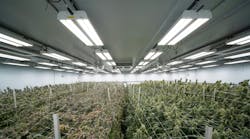Servizi Ambientali Bassa Reggiana in the Reggio province of Italy has reduced its basil production cycle by five days after transitioning from HPS lighting in its greenhouses to an SSL fixture that utilizes a mix of blue, red, hyper-red, and far-red LEDs from Osram.
Osram Opto Semiconductors has released the details of a horticultural lighting project in Italy in which LED-based fixtures developed by Ambra Elettronica have been deployed in greenhouses used for basil production. Grower Servizi Ambientali Bassa Reggiana (S.A.BA.R.), located in the Reggio province between Parma and Bologna, has slashed energy usage by 56% relative to the high-pressure sodium (HPS) lighting used previously, and increased yield via a five-day-shorter production cycle enabled by the solid-state lighting (SSL).
Interested in articles & announcements on horticultural lighting?
Fixture manufacturer Ambra is a member of the Osram LED Light For you (LLFY) SSL-centric partnership program and offers a number of LED-based horticultural lighting products. The range includes the 42W AE32 fixture for vertical farming, a number of linear products intended for greenhouse applications, and the 200W AE200 rectangular fixtures that can provide the greatest intensity in a focused area.
A horticultural lighting fixture developed by Ambra Elettronica uses a mix of Osram LEDs to reduce the basil production cycle as well as energy usage at an Italian grower.
The basil greenhouse relies on the AE80 linear fixture that measures 1200 mm in length. The 100W product can deliver PAR (photosynthetically active radiation)-spectrum photosynthetic photon flux (PPF) of 210–230 μmoles/sec depending on the mix of LEDs used in the product. Ambra offers configurations with different mixes of 450-nm blue, 620-nm red, 660-nm hyper-red, and 730-nm far-red Osram Oslon LEDs. The efficiency of the fixture is 2.2 μmoles/J. For more details on metrics for horticultural lighting products, see one our recent feature articles that covered the topic.
S.A.BA.R. said the prior HPS lighting required 32 kW of power whereas the LED lighting reduced that load to 14 kW. Annual energy savings total 75,000 kWh or what Osram equates to 30 tons of carbon emissions. Still, what may be more important is the reduction in the production cycle by five days for each crop cycle.
“We are very satisfied with the AmbraLight solution,” said Marco Boselli, CEO of S.A.BA.R. “The production of basil utilizing Oslon LEDs with red, hyper red, and blue in different proportions has increased the crop and did not cause any problems. We were worried about proliferation problems, because the peronospara fungus was previously eradicated by the heat generated by HPS lighting, but didn’t experience any. We could also observe a better and faster growth of our basil due to the lower percentage of blue light — which is 5% with the LED solution compared to 25% with our former HPS solution.”
Osram was perhaps the first LED manufacturer to deliver a far-red LED in its portfolio back in 2015. The company had previously offered the blue, red, and hyper-red products that are utilized due to spectrum matches with plant chlorophyll absorption peaks and the impact on photosynthesis. The far-red LEDs can be used to manipulate plant growth and flowering. We detailed the science behind such spectrum choices in a prior article. Watch the video below for more information on Osram LEDs for horticultural lighting.
The broad LED choice led Ambra, a specialist in horticultural applications for professional and home usage, to the Oslon family. “Osram Opto Semiconductors offers a comprehensive portfolio for horticultural applications and allow us to achieve the best possible color mix and intensity for specific demands of different plants,” said Maurizio Fasolo, CEO at Ambra. “They also provide the basis to design lamps withstanding the harsh environment of modern greenhouse, being resistant to moisture, temperature fluctuations and dust, and to sustain a long term heavy duty working cycle.”







